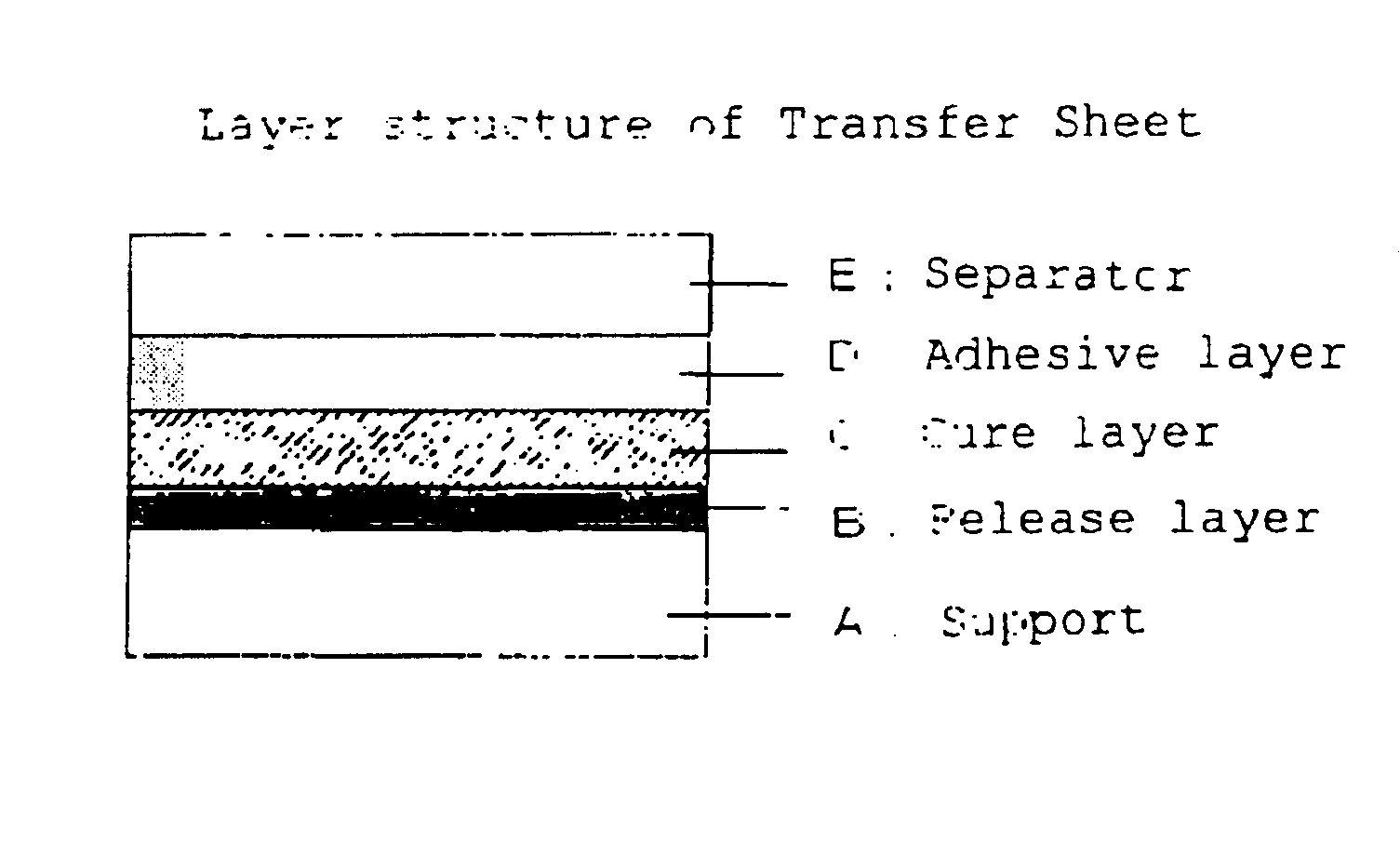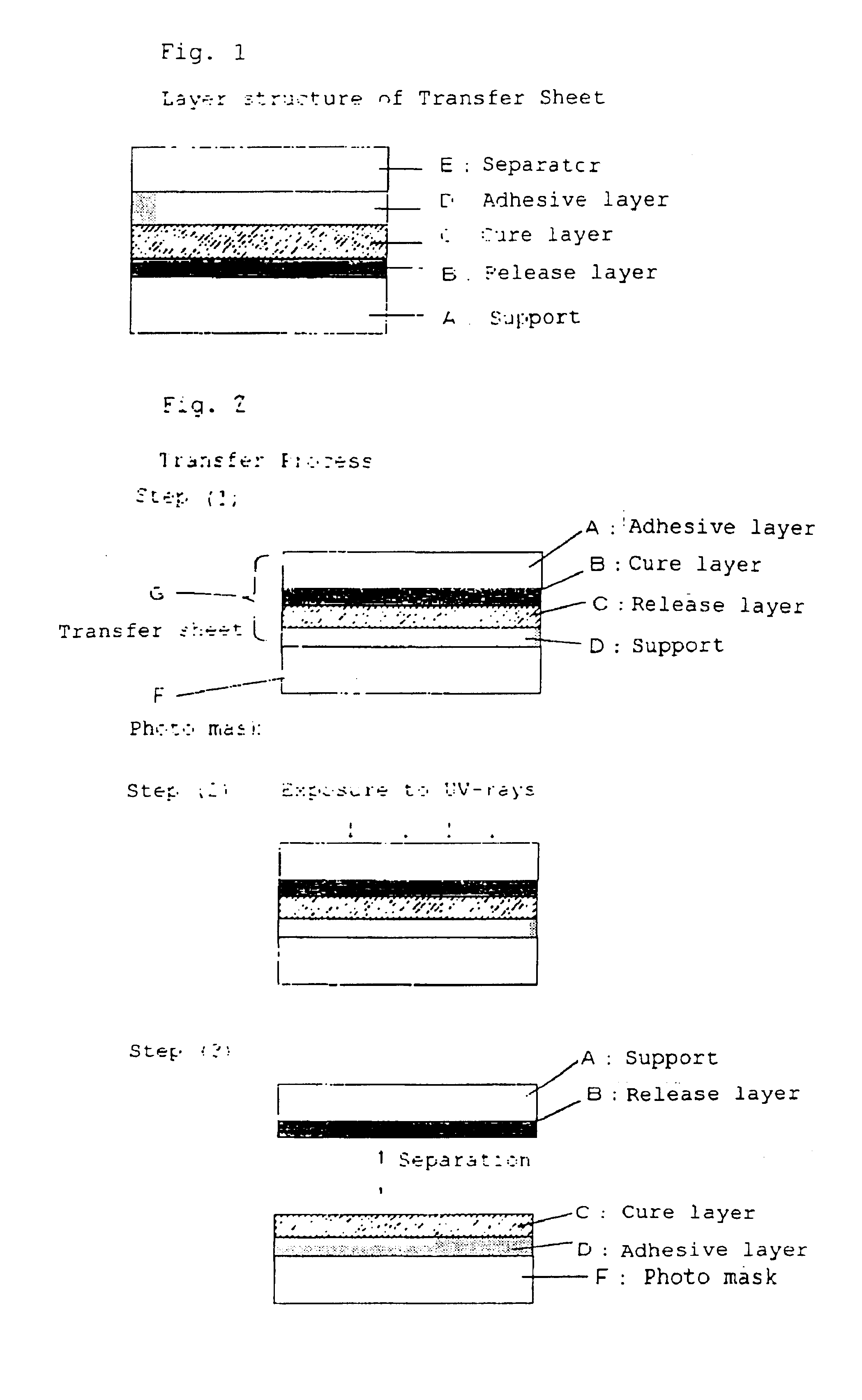Transfer sheet for transferring protective layer for photographic emulsion face and photomask with protective layer
a technology of transfer sheet and protective layer, which is applied in the direction of auxillary/base layer of photosensitive materials, instruments, photosensitive materials, etc., can solve the problems of unfit transfer layer, complex protective layer formation process, and inability to ensure sufficient strength of the transferred layer as a whole, etc., to achieve easy adhesion, high strength, and high adhesion
- Summary
- Abstract
- Description
- Claims
- Application Information
AI Technical Summary
Benefits of technology
Problems solved by technology
Method used
Image
Examples
example 1
(1) Preparation of Support:
On one side of a biaxially stretched 50 μm-thick polyethylene terephthalate (abbreviated as “PET” hereinafter) film, the following release layer forming solution was coated by means of a roll coater, and dried for 1 minute at 130° C. Thus, a release layer having a thickness of 2 μm was formed.
<Release Layer Forming Solution>
(a) Acrylamide copolymer (Tesfine 322, trade name, a product of Hitachi Kasei Polymer Co., Ltd.): 1.8 parts(b) Epoxy-melamine copolymer (SP-DRC No. 153N, trade name, a product of Dainippon Ink and Chemicals, Inc.): 41 parts(c) Paratoluenesulfonic acid (Dryer 900, trade name, a product of Hitachi Kasei Polymer Co., Ltd.): 0.2 parts
(d) Solvent:ethyl acetate46partsmethyl ethyl ketone11parts
(2) Preparation of Photographic Emulsion Surface Protective Layer in Uncured State:
On the release layer of the support prepared in (1), the following solution for forming a photographic emulsion surface protective layer in an uncured state was coate...
example 2
A transfer sheet was prepared in the same manner as in Example 1, except that the solution for forming the photographic emulsion surface protective layer in an uncured state was replaced by the following solution. The curing index of the thus formed photographic emulsion surface protective layer in the uncured state was 150.
<Solution for Forming Photographic Emulsion Surface Protective Layer>
(Ionized Radiation Curable Resin Composition)
(a) Trifunctional acrylate (Aronix M-309, trade name, a product of Toagosei Chemical Industry Co., Ltd.): 12 parts(b) COOH group-containing monofunctional acrylate (Aronix M-5400, trade name, a product of Toagosei Chemical Industry Co., Ltd.): 9 parts(c) Polyamine (an acrylic graft copolymer, L-40M, trade name, a product of Soken Chemical & Engineering Co., Ltd.): 9 parts(d) Reaction initiator (Lucirin TPO, trade name, a product of BASF Japan Ltd.): 0.1 parts
(e) Diluent:ethyl acetate17.2partsmethyl ethyl ketone17.2partsethyl cellosolve8.5parts
By ...
example 3
A transfer sheet and protective layer-covered photomasks were prepared in the same manners as in Example 1, except that the solution for forming the photographic emulsion surface protective layer in an uncured state was replaced by the following solution. The curing index of the thus formed photographic emulsion surface protective layer in the uncured state was 130.
<Solution for Forming Photographic Emulsion Surface Protective Layer>
(Ionized Radiation Curable Resin Composition)
(a) Trifunctional acrylate (Aronix M-309, trade name, a product of Toagosei Chemical Industry Co., Ltd.): 9 parts(b) COOH group-containing monofunctional acrylate (Aronix M-5400, trade name, a product of Toagosei Chemical Industry Co., Ltd.): 12 parts(c) Polyamine (an acrylic comb copolymer, L-40M, trade name, a product of Soken Chemical & Engineering Co., Ltd.): 9 parts(d) Reaction initiator (Lucirin TPO, trade name, a product of BASF Japan Ltd.): 0.1 parts
(e) Diluent:ethyl acetate17.2partsmethyl ethyl k...
PUM
| Property | Measurement | Unit |
|---|---|---|
| surface roughness | aaaaa | aaaaa |
| surface roughness | aaaaa | aaaaa |
| thickness | aaaaa | aaaaa |
Abstract
Description
Claims
Application Information
 Login to View More
Login to View More - R&D
- Intellectual Property
- Life Sciences
- Materials
- Tech Scout
- Unparalleled Data Quality
- Higher Quality Content
- 60% Fewer Hallucinations
Browse by: Latest US Patents, China's latest patents, Technical Efficacy Thesaurus, Application Domain, Technology Topic, Popular Technical Reports.
© 2025 PatSnap. All rights reserved.Legal|Privacy policy|Modern Slavery Act Transparency Statement|Sitemap|About US| Contact US: help@patsnap.com


